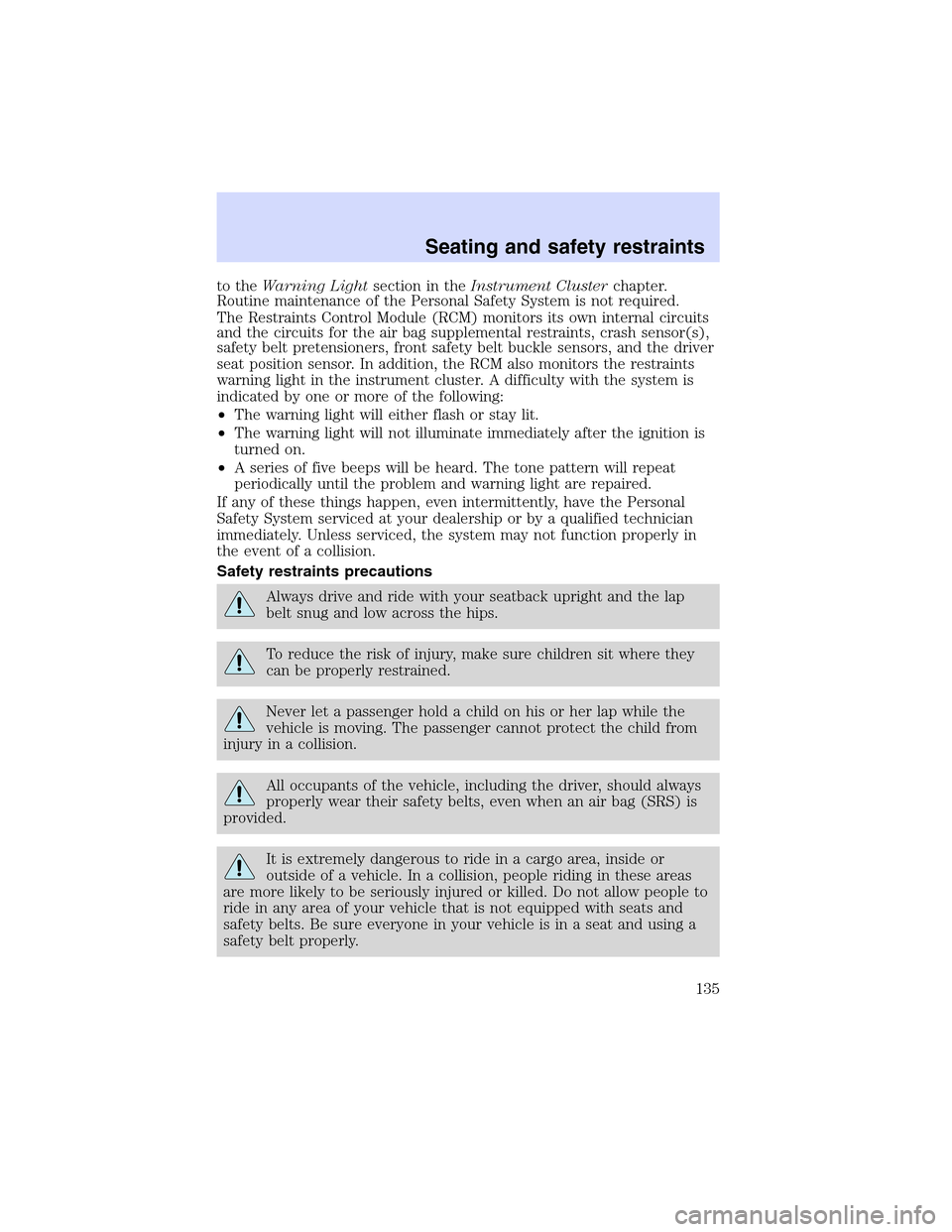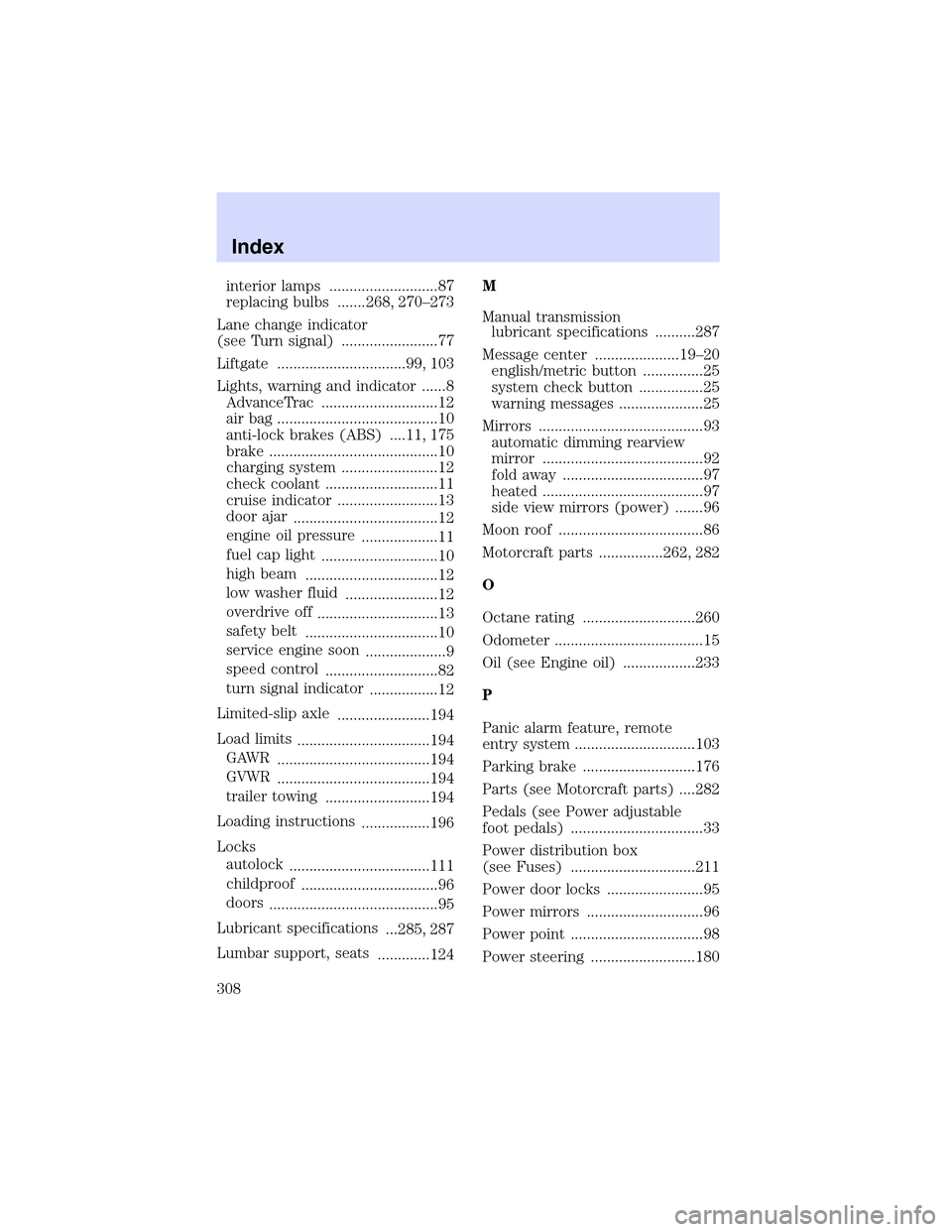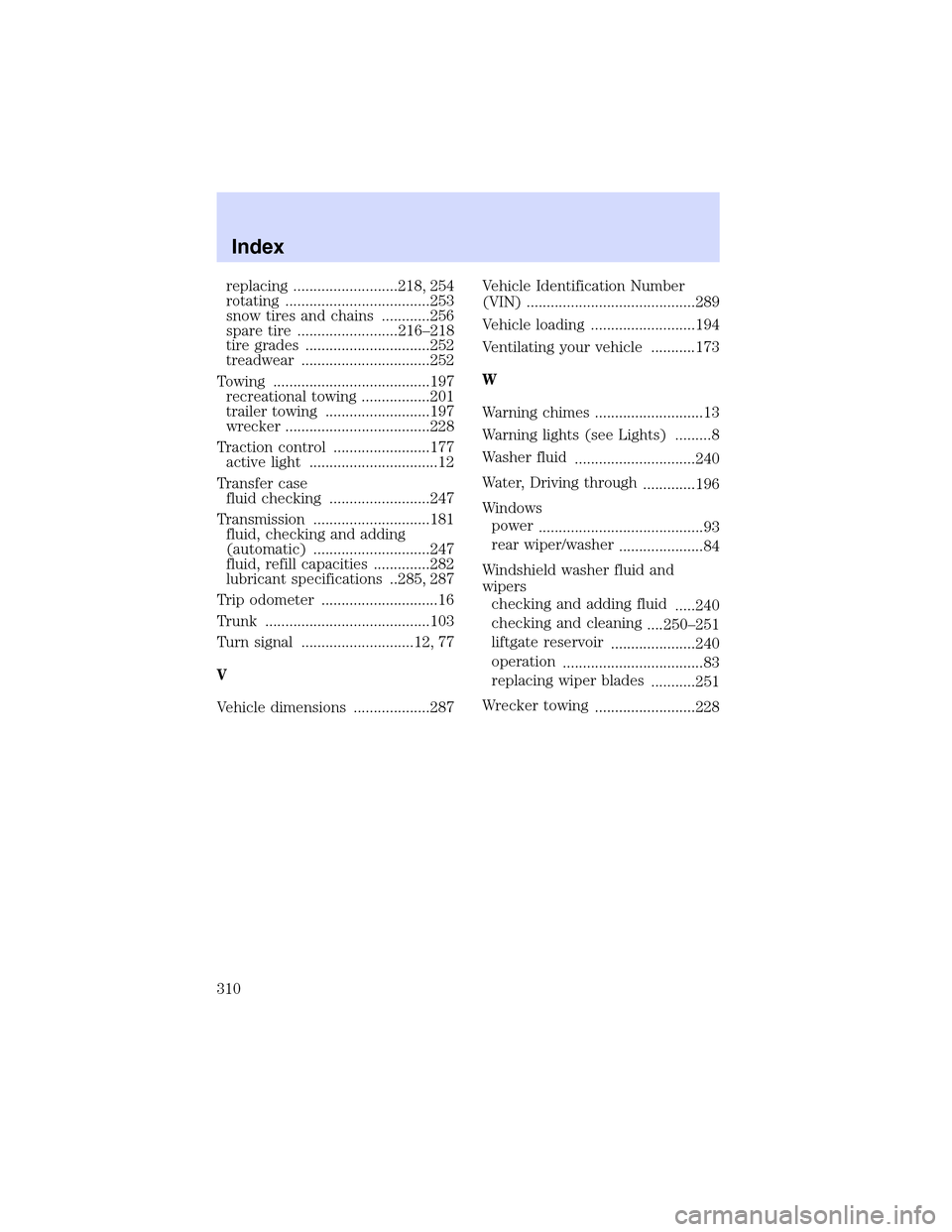lights Mercury Mountaineer 2002 s User Guide
[x] Cancel search | Manufacturer: MERCURY, Model Year: 2002, Model line: Mountaineer, Model: Mercury Mountaineer 2002Pages: 312, PDF Size: 3.02 MB
Page 106 of 312

Programming remote transmitters
It is necessary to haveall(maximum of four—original and/or new) of
your remote transmitters available prior to beginning this procedure.
To program the transmitters yourself:
•Insert a key in the ignition and
turn from 1 (LOCK) to 3 (ON)
and cycle between 1 (LOCK) and
3 (ON) eight times in rapid
succession (within 10 seconds)
with the eighth turn ending in the
3 (ON) position. The doors will
lock/unlock to confirm that
programming mode has been
entered.
•Within 20 seconds, program a remote transmitter by pressing any
button on a transmitter. The doors will lock/unlock to confirm that the
remote transmitter has been programmed. (If more than 20 seconds
pass before pressing a remote transmitter button, the programming
mode will exit and the procedure will have to be repeated.)
•Repeat the previous step to program additional remote transmitters.
The doors will lock/unlock to confirm that each remote transmitter has
been programmed.
•When you have completed programming the remote transmitters, turn
the ignition to 1 (LOCK) or wait 20 seconds. Again the doors will
lock/unlock to confirm programming has been completed.
Illuminated entry
The interior lamps illuminate when the remote entry system is used to
unlock the door(s).
The system automatically turns off after 25 seconds or when the ignition
is turned to the ON or ACC position. The dome lamp control (if
equipped) mustnotbe set to the OFF position for the illuminated entry
system to operate.
The inside lights will not turn off if:
•they have been turned on with the dimmer control, or
•any door is open.
The battery saver will shut off the interior lamps 10 minutes after the
ignition has been turned to the OFF position.
4
3
2
1
Controls and features
106
Page 133 of 312

SAFETY RESTRAINTS
Personal Safety System
The Personal Safety System provides an improved overall level of frontal
crash protection to front seat occupants and is designed to help further
reduce the risk of air bag-related injuries. The system is able to analyze
different occupant conditions and crash severity before activating the
appropriate safety devices to help better protect a range of occupants in
a variety of frontal crash situations.
Your vehicle’s Personal Safety System consists of:
•Driver and passenger dual-stage air bag supplemental restraints.
•Front safety belts with pretensioners, energy management retractors,
and safety belt usage sensors.
•Driver’s seat position sensor.
•Front crash severity sensor.
•Restraints Control Module (RCM) with impact and safing sensors.
•Restraint system warning light and back-up tone.
•The electrical wiring for the air bags, crash sensor(s), safety belt
pretensioners, front safety belt usage sensors, driver seat position
sensor, and indicator lights.
How does the personal safety system work?
The Personal Safety System can adapt the deployment strategy of your
vehicle’s safety devices according to crash severity and occupant
conditions. A collection of crash and occupant sensors provides
information to the Restraints Control Module (RCM). During a crash, the
RCM activates the safety belt pretensioners and/or either one or both
stages of the dual-stage air bag supplemental restraints based on crash
severity and occupant conditions.
The fact that the pretensioners or air bags did not activate for both front
seat occupants in a collision does not mean that something is wrong with
the system. Rather, it means the Personal Safety System determined the
accident conditions (crash severity, belt usage, etc.) were not
appropriate to activate these safety devices. Front air bags are designed
to activate only in frontal and near-frontal collisions, not rollovers,
side-impacts, or rear-impacts unless the collision causes sufficient
longitudinal deceleration.
Driver and passenger dual-stage air bag supplemental restraints
The dual-stage air bags offer the capability to tailor the level of air bag
inflation energy. A lower, less forceful energy level is provided for more
Seating and safety restraints
133
Page 135 of 312

to theWarning Lightsection in theInstrument Clusterchapter.
Routine maintenance of the Personal Safety System is not required.
The Restraints Control Module (RCM) monitors its own internal circuits
and the circuits for the air bag supplemental restraints, crash sensor(s),
safety belt pretensioners, front safety belt buckle sensors, and the driver
seat position sensor. In addition, the RCM also monitors the restraints
warning light in the instrument cluster. A difficulty with the system is
indicated by one or more of the following:
•The warning light will either flash or stay lit.
•The warning light will not illuminate immediately after the ignition is
turned on.
•A series of five beeps will be heard. The tone pattern will repeat
periodically until the problem and warning light are repaired.
If any of these things happen, even intermittently, have the Personal
Safety System serviced at your dealership or by a qualified technician
immediately. Unless serviced, the system may not function properly in
the event of a collision.
Safety restraints precautions
Always drive and ride with your seatback upright and the lap
belt snug and low across the hips.
To reduce the risk of injury, make sure children sit where they
can be properly restrained.
Never let a passenger hold a child on his or her lap while the
vehicle is moving. The passenger cannot protect the child from
injury in a collision.
All occupants of the vehicle, including the driver, should always
properly wear their safety belts, even when an air bag (SRS) is
provided.
It is extremely dangerous to ride in a cargo area, inside or
outside of a vehicle. In a collision, people riding in these areas
are more likely to be seriously injured or killed. Do not allow people to
ride in any area of your vehicle that is not equipped with seats and
safety belts. Be sure everyone in your vehicle is in a seat and using a
safety belt properly.
Seating and safety restraints
135
Page 171 of 312

Make sure the corresponding lights illuminate or illuminate briefly. If a
light fails to illuminate, have the vehicle serviced.
•If the driver’s safety belt is fastened, the
light may not illuminate.
STARTING THE ENGINE
Note:Whenever you start your vehicle, release the key as soon as the
engine starts. Excessive cranking could damage the starter.
1. Turn the key to 4 (START)
without pressing the accelerator
pedal and release as soon as the
engine starts. The key will return to
3 (ON).
2. If the temperature is above–12°C
(10°F) and the engine does not
start within five seconds on the first
try, turn the key to OFF, wait 10
seconds and try again.
3. If the temperature is below -12°C (10°F) and the engine does not
start in 15 seconds on the first try, turn the key OFF and wait 10
seconds and try again. If the engine does not start in two attempts, press
the accelerator pedal all the way to floor and hold. Turn the key to
START position.
4. When the engine starts, release the key, then release the accelerator
pedal gradually as the engine speeds up.
5. After idling for a few seconds, apply the brake, shift into gear and
drive.
Cold weather starting (flexible fuel vehicles only)
As the outside temperature approaches freezing, ethanol fuel distributors
should supply winter grade ethanol (same as with unleaded gasoline). If
O/D
OFF
BRAKE
SERVICE
ENGINE
SOON
HI TEMP
LOW OIL
4
3
2
1
Starting
171
Page 205 of 312

Canadian customers who require roadside assistance, call
1–800–665–2006.
If you need to arrange roadside assistance for yourself, Ford Motor
Company will reimburse a reasonable amount. To obtain reimbursement
information, U.S. Ford or Mercury vehicles customers call
1-800-241-3673; Lincoln vehicle customers call 1–800–521–4140.
Canadian customers who need to obtain reimbursement information, call
1–800–665–2006.
Roadside coverage beyond basic warranty
In the United States, you may purchase additional roadside assistance
coverage beyond this period through the Ford Auto Club by contacting
your Ford or Lincoln Mercury dealer.
Similarly in Canada, for uninterrupted Roadside Assistance coverage, you
may purchase extended coverage prior to your Basic Warranty’s Roadside
Assistance expiring. For more information and enrollment, contact
1–877–294–2582 or visit our website at www.ford.ca.
HAZARD FLASHER
Use only in an emergency to warn traffic of vehicle breakdown,
approaching danger, etc. The hazard flashers can be operated when the
ignition is off.
•The hazard lights control is
located on top of the steering
column.
•Depress hazard lights control to
activate all hazard flashers
simultaneously.
•Depress control again to turn the
flashers off.
FUEL PUMP SHUT-OFF SWITCH
FUEL
RESET
The fuel pump shut-off switch is a device intended to stop the electric
fuel pump when your vehicle has been involved in a substantial jolt.
After a collision, if the engine cranks but does not start, the fuel pump
shut-off switch may have been activated.
Roadside emergencies
205
Page 267 of 312

Exhaust leaks may result in entry of harmful and potentially
lethal fumes into the passenger compartment.
Do not make any unauthorized changes to your vehicle or engine. By
law, vehicle owners and anyone who manufactures, repairs, services,
sells, leases, trades vehicles, or supervises a fleet of vehicles are not
permitted to intentionally remove an emission control device or prevent
it from working. Information about your vehicle’s emission system is on
the Vehicle Emission Control Information Decal located on or near the
engine. This decal identifies engine displacement and gives some tune up
specifications.
Please consult yourWarranty Guidefor complete emission warranty
information.
Readiness for Inspection/Maintenance (I/M) testing
In some localities, it may be a legal requirement to pass an I/M test of
the on-board diagnostics system. If your“Check Engine/Service Engine
Soon”light is on, refer to the description in theWarning lights and
chimessection of theInstrumentationchapter. Your vehicle may not
pass the I/M test with the“Check Engine/Service Engine Soon”light on.
If the vehicle’s powertrain system or its battery has just been serviced,
the on-board diagnostics system is reset to a“not ready for I/M test”
condition. To ready the on-board diagnostics system for I/M testing, a
minimum of 30 minutes of city and highway driving is necessary as
described below:
•First, at least 10 minutes of driving on an expressway or highway.
•Next, at least 20 minutes driving in stop-and-go, city-type traffic with
at least four idle periods.
Allow the vehicle to sit for at least eight hours without starting the
engine. Then, start the engine and complete the above driving cycle. The
engine must warm up to its normal operating temperature. Once started,
do not turn off the engine until the above driving cycle is complete.
Maintenance and care
267
Page 274 of 312

Function Number of bulbs Trade number
Park/turn lamps (front) 2 3157 AK (amber)
Headlamps 2 9007
Rear stop/turn/tail lamps 4 3057
Rear license plate lamps 2 168
Backup lamp 2 3156K
High-mount brake lamps 5 W5W
Side repeater 2 WY5W (amber)
Front sidemarker 2 194
Rear sidemarker 2 194
Fog lamp 2 9145
Cargo lamp 1 211-2
Interior overhead lamp 1 912 (906)
Front door courtesy
lamp1
168
Map lamps 2 168 (T10)
Ashtray lamp 1 161
All replacement bulbs are clear in color except where noted.
To replace all instrument panel lights - see your dealer.
VERTICAL AIM ADJUSTMENT
1. Park the vehicle on a level surface approximately 7.6 meters (25 feet)
from a vertical wall or screen directly in front of it.
•(1) Eight feet
•(2) Center height of lamp to ground
•(3) Twenty-five feet
Maintenance and care
274
Page 307 of 312

GAWR (Gross Axle Weight
Rating) .......................................194
calculating ...............................196
definition .................................194
driving with a heavy load ......194
location ....................................194
GVWR (Gross Vehicle Weight
Rating) .......................................194
calculating .......................194, 196
definition .................................194
driving with a heavy load ......194
location ....................................194
H
Hazard flashers .........................205
Head restraints .................120, 125
Headlamps ...................................31
aiming ......................................274
autolamp system .......................33
bulb specifications ..................273
daytime running lights .............31
flash to pass ..............................32
high beam ...........................12, 32
replacing bulbs .......................268
turning on and off ....................31
warning chime ..........................13
Heating ........................................36
heating and air conditioning
system .......................................36
rear seat controls .....................51
HomeLink universal
transceiver (see Garage door
opener) ...................... 88–89, 91–92
Hood ..........................................230
I
Ignition .................................78, 287Infant seats
(see Safety seats) .....................161
Inspection/maintenance (I/M)
testing ........................................267
Instrument panel
cleaning ...................................279
cluster ..........................................8
lighting up panel and
interior .......................................32
location of components ..............8
J
Jack ....................................216–217
positioning .......................216, 218
storage .....................216–217, 221
Jump-starting your vehicle ......222
K
Keyless entry system ...............107
autolock ...................................111
keypad .....................................107
locking and unlocking doors ..110
programming entry code .......108
Keys ...................................116–118
key in ignition chime ...............13
positions of the ignition ...........78
L
Lamps
autolamp system .......................33
bulb replacement
specifications chart ................273
cargo lamps ...............................32
daytime running light ...............31
fog lamps ...................................31
headlamps .................................31
headlamps, flash to pass ..........32
instrument panel, dimming .....32
Index
307
Page 308 of 312

interior lamps ...........................87
replacing bulbs .......268, 270–273
Lane change indicator
(see Turn signal) ........................77
Liftgate ................................99, 103
Lights, warning and indicator ......8
AdvanceTrac .............................12
air bag ........................................10
anti-lock brakes (ABS) ....11, 175
brake ..........................................10
charging system ........................12
check coolant ............................11
cruise indicator .........................13
door ajar
....................................12
engine oil pressure
...................11
fuel cap light
.............................10
high beam
.................................12
low washer fluid
.......................12
overdrive off
..............................13
safety belt
.................................10
service engine soon
....................9
speed control
............................82
turn signal indicator
.................12
Limited-slip axle
.......................194
Load limits
.................................194
GAWR
......................................194
GVWR
......................................194
trailer towing
..........................194
Loading instructions
.................196
Locks
autolock
...................................111
childproof
..................................96
doors
..........................................95
Lubricant specifications
...285, 287
Lumbar support, seats
.............124M
Manual transmission
lubricant specifications ..........287
Message center .....................19–20
english/metric button ...............25
system check button ................25
warning messages .....................25
Mirrors .........................................93
automatic dimming rearview
mirror ........................................92
fold away ...................................97
heated ........................................97
side view mirrors (power) .......96
Moon roof ....................................86
Motorcraft parts ................262, 282
O
Octane rating ............................260
Odometer .....................................15
Oil (see Engine oil) ..................233
P
Panic alarm feature, remote
entry system ..............................103
Parking brake ............................176
Parts (see Motorcraft parts) ....282
Pedals (see Power adjustable
foot pedals) .................................33
Power distribution box
(see Fuses) ...............................211
Power door locks ........................95
Power mirrors .............................96
Power point .................................98
Power steering ..........................180
Index
308
Page 310 of 312

replacing ..........................218, 254
rotating ....................................253
snow tires and chains ............256
spare tire .........................216–218
tire grades ...............................252
treadwear ................................252
Towing .......................................197
recreational towing .................201
trailer towing ..........................197
wrecker ....................................228
Traction control ........................177
active light ................................12
Transfer case
fluid checking .........................247
Transmission .............................181
fluid, checking and adding
(automatic) .............................247
fluid, refill capacities ..............282
lubricant specifications ..285, 287
Trip odometer .............................16
Trunk .........................................103
Turn signal ............................12, 77
V
Vehicle dimensions ...................287Vehicle Identification Number
(VIN) ..........................................289
Vehicle loading ..........................194
Ventilating your vehicle ...........173
W
Warning chimes ...........................13
Warning lights (see Lights) .........8
Washer fluid
..............................240
Water, Driving through
.............196
Windows
power
.........................................93
rear wiper/washer
.....................84
Windshield washer fluid and
wipers
checking and adding fluid
.....240
checking and cleaning
....250–251
liftgate reservoir
.....................240
operation
...................................83
replacing wiper blades
...........251
Wrecker towing
.........................228
Index
310